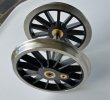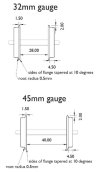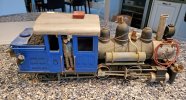Or a shelf indoors railway at 4ft high inches away.and if you're going to worry about out of scale flanges at that viewing distance, you've got problems

You are using an out of date browser. It may not display this or other websites correctly.
You should upgrade or use an alternative browser.
You should upgrade or use an alternative browser.
Sources of small metal wheels?
- Thread starter Fred2179G
- Start date
Rhinochugger
Retired Oik
Well, you might notice the difference there - whether it worries you is a different matterOr a shelf indoors railway at 4ft high inches away.
Fred2179G
Registered
That may be true of Slaters Gauge-1 or similar wheels, but my Slaters 16mm scale narrow gauge wheels are 5.1mm wide, whereas the LGB Feldbahn wheels (and others) are 7mm wide (tread+flange). Slaters wheels do not match the 16mm Association standards, which call for a 1.5mm wide flange (Slaters is 1mm) and a 4.5mm tread (Slaters=4mm.)Over here, there's not much between Slater's and LGB in terms of tread width.
And, as I have mentioned, it is not the look of the wheels; it's the fact that they drop into the 45mm gauge track. One side will be on the rail, but when its flange is against the rail the other wheel tread is inside the rail and drops onto the ballast.
Last edited:
Rhinochugger
Retired Oik
I've heard this complaint before about Slater's wheels, but mine stay on the track OK, and for plenty of people in the in the UK they are the supplier of choice for wheels in all scales.That may be true of Slaters Gauge-1 or similar wheels, but my Slaters 16mm scale narrow gauge wheels are 5.1mm wide, whereas the LGB Feldbahn wheels (and others) are 7mm wide (tread+flange). Slaters wheels do not match the 16mm Association standards, which call for a 1.5mm wide flange (Slaters is 1mm) and a 4.5mm tread (Slaters=4mm.)
And, as I have mentioned, it is not the look of the wheels; it's the fact that they drop into the 45mm gauge track. One side will be on the rail, but when its flange is against the rail the other wheel tread is inside the rail and drops onto the ballast.
The driving wheels on my 2-6-2 are made with either 32mm gauge axles or 45mm gauge axles, and I have the latter - they were available through GRS in Buckinghamshire.
I'm on a bit of a flakey internet connection down here, and am not able to rifle through the Slater's catalogue.
Fred2179G
Registered
I, too, like their wheels. Slaters sell a gauge-3, 4’ 6" 13 Spoke driving wheels, which became a pair of 1:20 scale 48.3" wheels for an East Broad Top Mikado [should be 48" but who's counting.]the supplier of choice for wheels in all scales.

My notes from the time I reported on them:
back-to-back: 1.578"
crank throw: 0.45"
diameter over tread: 2.38" (which is 48.314" in Fn3)
width: 0.275"
flange: 0.090"
Significantly wider than the 16mm wheels.
TBH that seems like a wrong ly gauged set of wheelsThat may be true of Slaters Gauge-1 or similar wheels, but my Slaters 16mm scale narrow gauge wheels are 5.1mm wide, whereas the LGB Feldbahn wheels (and others) are 7mm wide (tread+flange). Slaters wheels do not match the 16mm Association standards, which call for a 1.5mm wide flange (Slaters is 1mm) and a 4.5mm tread (Slaters=4mm.)
And, as I have mentioned, it is not the look of the wheels; it's the fact that they drop into the 45mm gauge track. One side will be on the rail, but when its flange is against the rail the other wheel tread is inside the rail and drops onto the ballast.
Rhinochugger
Retired Oik
16mm Association standards are intended for 32mm track, not 45mm.That may be true of Slaters Gauge-1 or similar wheels, but my Slaters 16mm scale narrow gauge wheels are 5.1mm wide, whereas the LGB Feldbahn wheels (and others) are 7mm wide (tread+flange). Slaters wheels do not match the 16mm Association standards, which call for a 1.5mm wide flange (Slaters is 1mm) and a 4.5mm tread (Slaters=4mm.)
And, as I have mentioned, it is not the look of the wheels; it's the fact that they drop into the 45mm gauge track. One side will be on the rail, but when its flange is against the rail the other wheel tread is inside the rail and drops onto the ballast.
I cannot see any manufacturer making a wheelset that won't run on the stated gauge. Wheel standards tend to be more crucial on pointwork.
It sounds like you have a mis-matched axle with the wheel type - I can think of no other explanation.
For 16mm:1ft, Slater's not only make wheelsets, but also loco and wagon kits, and we'd hear the uproar over here if they made something that wouldn't run on the ready-made tracks. The main railway magazine over here, which regularly reviews new products, is Railway Modeller, produced by Peco, who also make a range of SM32 track and G45 track. We'd hear about it if Slater's wagons didn't run on their track
Fred2179G
Registered
Indeed. I'm trying to use 32mm gauge wheels on a 45mm gauge axle.that seems like a wrong ly gauged set of wheels
Well, the Slaters 16mm wheels that I have clearly do not match the 16mm Association standards, which call for a 6mm wide wheel, not 5mm like these. I have no idea what track standards allow these wheels to work.16mm Association standards are intended for 32mm track, not 45mm.
I cannot see any manufacturer making a wheelset that won't run on the stated gauge.
The 16mm Assoc standards call for the same wheel dimensions whether 32mm gauge or 45mm gauge. Only the back to back is different. So it shouldn't make a difference.you have a mis-matched axle with the wheel type

As I mentioned, we first found this when a friend of mine bought a Smallbrook Studios motorized chassis with 45mm axles and found it dropped between the rails. There was an email conversation with Smallbrook, and I don't know if they still offer them.
Clearly I shouldn't be buying the wheels for my 45m gauge trains. But equally clear is that Slaters should make wheels to match the Association standards.
Rhinochugger
Retired Oik
That drawing from the 16mm Association is not an absolute standard - it has a caveat above it that reads thus:Indeed. I'm trying to use 32mm gauge wheels on a 45mm gauge axle.
Well, the Slaters 16mm wheels that I have clearly do not match the 16mm Association standards, which call for a 6mm wide wheel, not 5mm like these. I have no idea what track standards allow these wheels to work.
The 16mm Assoc standards call for the same wheel dimensions whether 32mm gauge or 45mm gauge. Only the back to back is different. So it shouldn't make a difference.
View attachment 314344
As I mentioned, we first found this when a friend of mine bought a Smallbrook Studios motorized chassis with 45mm axles and found it dropped between the rails. There was an email conversation with Smallbrook, and I don't know if they still offer them.
Clearly I shouldn't be buying the wheels for my 45m gauge trains. But equally clear is that Slaters should make wheels to match the Association standards.
The drawings below define a standard that works well enough for most types of track that you may encounter. On 32mm gauge that is mostly Peco or Tenmille (which covers approximately 90% of the 32mm tracks) and on 45mm gauge stock with this profile has been used on handmade track with code 250 rail, commercial code 250 track, commercial code 332 track and points from Aristocraft and LGB.
How did you buy 16mm scale wheels with 45mm axles?
Did you buy the wheels direct from Slater's?
If so, do you have a reference number?
Fred2179G
Registered
1612DIN 16mm NG Wheels: 1'0" 6 Curly Spoke Wagondo you have a reference number?
Wheel (Dinorwic)
1615WD 16mm NG Wheels: 1'3" 7 Curly Spoke Wagon
Wheel (WAR DEPARTMENT)
P.S. I did find my correspondence with Slaters, who statd their wheels were 5mm across, and we shouldn't be using scale wheels on oversized LGB track!
I also found the photo of the original problem:
We did discuss this at the time:
Slaters 16mm wheels on 45mm axles?
Rhinochugger
Retired Oik
Yes, I remember the discussion, and there is clearly something wrong with the back-to-back on that motor block.1612DIN 16mm NG Wheels: 1'0" 6 Curly Spoke Wagon
Wheel (Dinorwic)
1615WD 16mm NG Wheels: 1'3" 7 Curly Spoke Wagon
Wheel (WAR DEPARTMENT)
P.S. I did find my correspondence with Slaters, who statd their wheels were 5mm across, and we shouldn't be using scale wheels on oversized LGB track!
I also found the photo of the original problem:

We did discuss this at the time:
Slaters 16mm wheels on 45mm axles?
45mm standards are for a back-to-back of 40.5 mm. although the wheel treads are only 4 mm, you have one flange which accounts for 1 mm, so the distance between the outside edge of the flange of the lower wheel, and the edge of the upper wheel will be 45.5 mm - tight, but not enough to fall between the tracks as in that photo. Equally, many people successfully run a back-to-back of 41mm, whcih will give you a worst case of 1mm of tread on the rail.
Also, according to G1MRA, you could push the back-to-back out even further so that back-to-back with one flange is up to 42 mm.
Clearly you're not going to get anywhere with Slater's as you're using their wheels in a way that they didn't design them for. So, making them work is the next challenge, and that looks like opening up the back-to-back a little. However, you'll need to check the running through some pointwork when you do this.
Either that, or you're back to LGB Feldbahn wheels with their fat treads
3 minutes of fame
3d printing, electronics and trams
It is possible to adjust the back to back on Slaters wheels, simply by adding washers over the square axle section, between the round section and wheel. I had to do this on a set of G1 driving wheels, where the back to back was a little tight. Both treads were on the rails however, it was just a little tight through the points.
Fred2179G
Registered
Which is exactly what I did, and they run fine on my pal's layout, which is mostly LGB and Aristo track. But I would expect problems on some track/points/switches, as you say.that looks like opening up the back-to-back a little.
Naw, they are too big. I did find some K-line handcar wheels, which are 0.75" and will work. The application is a trailing truck on a Forney, so they are almost invisible anyway. But there's only just a little height for the wheels.back to LGB Feldbahn wheels

Fred2179G
Registered
That's one suggestion they made when I complained last time. These are wagon wheels, so they aren't squared and you can open the back-to-back by tapping them in a vice with a hammer.It is possible to adjust the back to back on Slaters wheels,
But they were perfectly set on the standard shouldered 45mm wagon axle at 40mm before I started. They are now at 41+mm which may or may not be a problem in the future.
3 minutes of fame
3d printing, electronics and trams
Mine are set to 41.5mm, and all runs correctly. I run gauge widened G1 track and never have an issue with wheels falling through the rails, just bumping or binding on the points, something that widening the gauge slightly fixed.
Rhinochugger
Retired Oik
Yeah, 40mm is tight for B-2-B.That's one suggestion they made when I complained last time. These are wagon wheels, so they aren't squared and you can open the back-to-back by tapping them in a vice with a hammer.
But they were perfectly set on the standard shouldered 45mm wagon axle at 40mm before I started. They are now at 41+mm which may or may not be a problem in the future.
Rhinochugger
Retired Oik
As with all things, there is a prototype for everything, and LTC Rolt in his book about the early preservation days of the Tallylyn Railway describes how a loco that they bought from the Corris Railway did exactly what we've been talking about, and fell between the rails 


Rhinochugger
Retired Oik
It wouldin't surprise me if Slater's 16mm wheels were to Gauge 0 standards - after all, why re-invent the wheel (s'cuse the pun) ? 32 mm gauge has been around for years, and although there are two standards in the UK (coarse and fine) the coarse is really only for the old tin-plate models.Which is exactly what I did, and they run fine on my pal's layout, which is mostly LGB and Aristo track. But I would expect problems on some track/points/switches, as you say.
Naw, they are too big. I did find some K-line handcar wheels, which are 0.75" and will work. The application is a trailing truck on a Forney, so they are almost invisible anyway. But there's only just a little height for the wheels.
View attachment 314354
There's no need to invent another wheel standard just because you're putting another size of body on top of the chassis. Same as G45, it tends to run to G1MRA standards (apart from LGB wheels) but the trackwork operates to the standards. As a result, I run all sorts of manufacturers' wheels on my line and they only de-rail when there's an obstacle, or I've forgotten to re-set some points
JimmyB
Now retired - trains and fishing
If I recall wheels are standard and fine, and denoted by the part number.It wouldin't surprise me if Slater's 16mm wheels were to Gauge 0 standards - after all, why re-invent the wheel (s'cuse the pun) ? 32 mm gauge has been around for years, and although there are two standards in the UK (coarse and fine) the coarse is really only for the old tin-plate models.
There's no need to invent another wheel standard just because you're putting another size of body on top of the chassis. Same as G45, it tends to run to G1MRA standards (apart from LGB wheels) but the trackwork operates to the standards. As a result, I run all sorts of manufacturers' wheels on my line and they only de-rail when there's an obstacle, or I've forgotten to re-set some points
